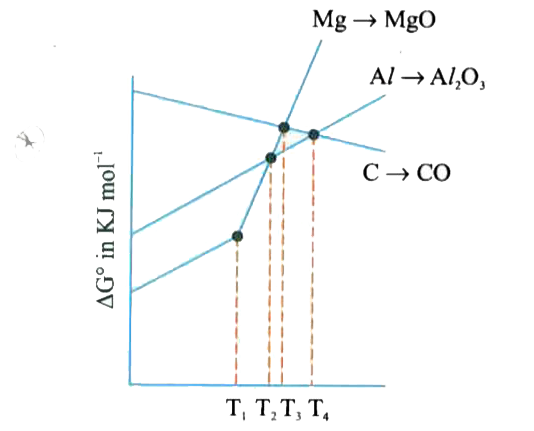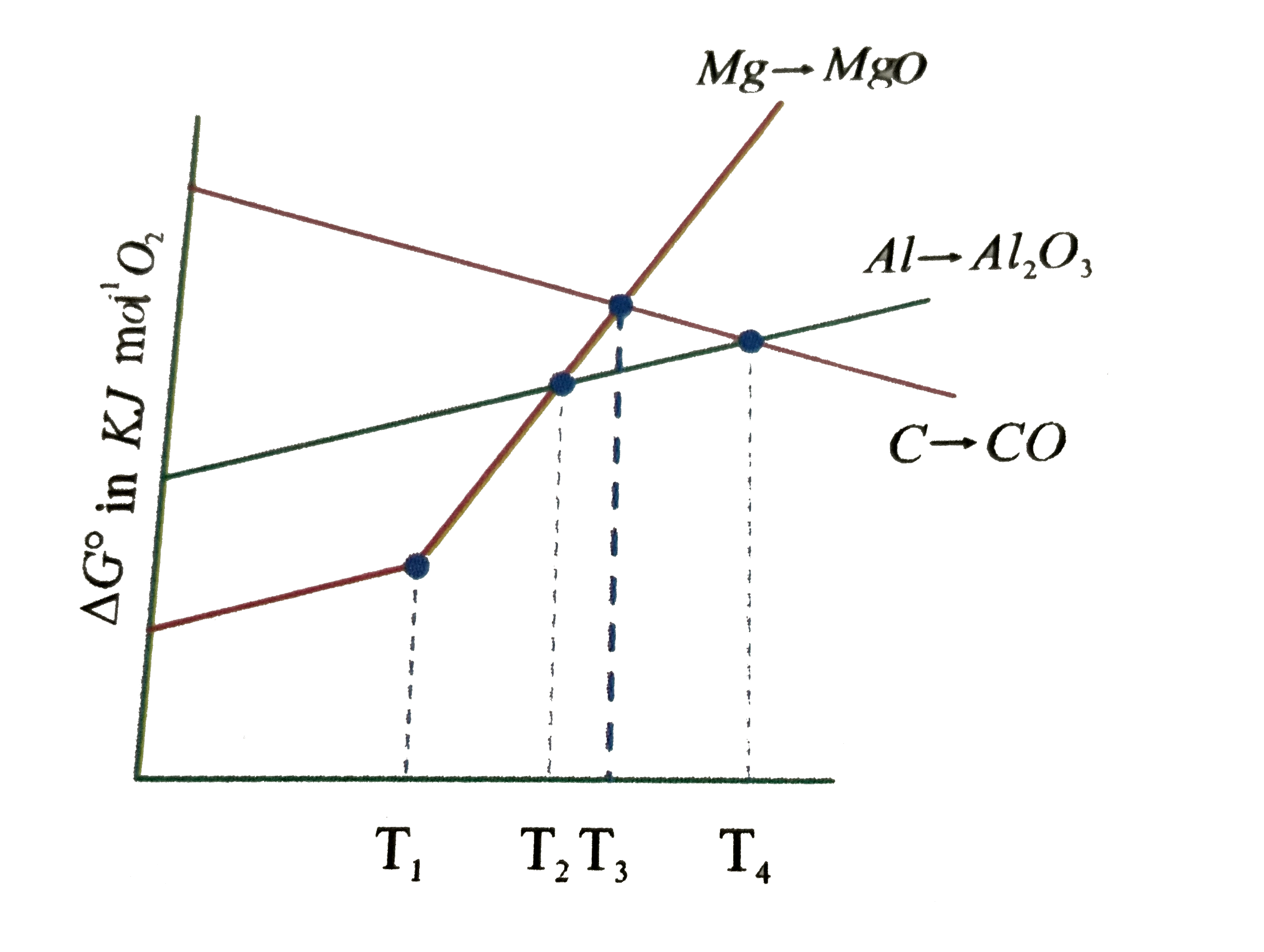In Ellingham diagrams plots of ΔG (oxide formation) show positive slopes except for the formation of CO(g) from coke. Why?
To answer the question regarding why the Ellingham diagram shows positive slopes for most oxide formations, except for the formation of carbon monoxide (CO) from coke, we can break down the explanation into several steps:
1. Understanding Ellingham Diagrams:
- Ellingham diagrams plot the Gibbs free energy change (ΔG) for the formation of oxides as a function of temperature. A positive slope indicates that the formation of the oxide becomes less favorable as temperature increases.
2. Formation of Carbon Monoxide from Coke:
- The reaction in question is the formation of CO from solid carbon (coke). The balanced equation for this reaction is:
2C(s)+O2(g)→2CO(g)
- Here, we see that solid carbon reacts with gaseous oxygen to form gaseous carbon monoxide.
3. Analyzing ΔG for the Reaction:
- The Gibbs free energy change can be expressed as:
ΔG=ΔH−TΔS
- For the formation of CO from coke, we need to consider both ΔH (enthalpy change) and ΔS (entropy change).
4. Enthalpy Change (ΔH):
- The formation of CO from coke is an exothermic reaction, meaning that ΔH is negative. This is because energy is released when bonds are formed in the product (CO).
5. Entropy Change (ΔS):
- In this reaction, we start with 2 moles of solid carbon (C) and produce 2 moles of gaseous carbon monoxide (CO). The transition from solid to gas increases the randomness or disorder of the system, which means ΔS is positive.
6. Effect of Temperature on ΔG:
- Since ΔH is negative and ΔS is positive, as the temperature (T) increases, the term TΔS becomes more significant. This results in ΔG becoming more negative, leading to a negative slope in the Ellingham diagram for the formation of CO.
7. Comparison with Other Oxide Formations:
- For most other metal oxide formations, the reaction involves the formation of solid metal oxides from gaseous reactants (like O2). In these cases, the entropy decreases (ΔS is negative), which means that as temperature increases, TΔS becomes less negative or even positive, leading to a positive slope in the Ellingham diagram.
8. Conclusion:
- Therefore, the unique behavior of the formation of CO from coke, with a negative slope in the Ellingham diagram, is due to the combination of a negative ΔH (exothermic reaction) and a positive ΔS (increase in entropy) that dominates the Gibbs free energy change at higher temperatures.
- Ellingham diagrams plot the Gibbs free energy change (ΔG) for the formation of oxides as a function of temperature. A positive slope indicates that the formation of the oxide becomes less favorable as temperature increases.
- The reaction in question is the formation of CO from solid carbon (coke). The balanced equation for this reaction is:
2C(s)+O2(g)→2CO(g)
- Here, we see that solid carbon reacts with gaseous oxygen to form gaseous carbon monoxide.
- The Gibbs free energy change can be expressed as:
ΔG=ΔH−TΔS
- For the formation of CO from coke, we need to consider both ΔH (enthalpy change) and ΔS (entropy change).
- The formation of CO from coke is an exothermic reaction, meaning that ΔH is negative. This is because energy is released when bonds are formed in the product (CO).
- In this reaction, we start with 2 moles of solid carbon (C) and produce 2 moles of gaseous carbon monoxide (CO). The transition from solid to gas increases the randomness or disorder of the system, which means ΔS is positive.
- Since ΔH is negative and ΔS is positive, as the temperature (T) increases, the term TΔS becomes more significant. This results in ΔG becoming more negative, leading to a negative slope in the Ellingham diagram for the formation of CO.
- For most other metal oxide formations, the reaction involves the formation of solid metal oxides from gaseous reactants (like O2). In these cases, the entropy decreases (ΔS is negative), which means that as temperature increases, TΔS becomes less negative or even positive, leading to a positive slope in the Ellingham diagram.
- Therefore, the unique behavior of the formation of CO from coke, with a negative slope in the Ellingham diagram, is due to the combination of a negative ΔH (exothermic reaction) and a positive ΔS (increase in entropy) that dominates the Gibbs free energy change at higher temperatures.
Topper's Solved these Questions
- GENERAL PRINCIPLES AND PROCESSES OF ISOLATION OF ELEMENTSBOOK - AAKASH INSTITUTECHAPTER - GENERAL PRINCIPLES AND PROCESSES OF ISOLATION OF ELEMENTSEXERCISE - Try yourself
33 Videos
- GENERAL PRINCIPLES AND PROCESSES OF ISOLATION OF ELEMENTSBOOK - AAKASH INSTITUTECHAPTER - GENERAL PRINCIPLES AND PROCESSES OF ISOLATION OF ELEMENTSEXERCISE - Exercise
20 Videos
- EQUILIBRIUMBOOK - AAKASH INSTITUTECHAPTER - EQUILIBRIUMEXERCISE - ASSIGNMENT (SECTION -D)
20 Videos
- GENERAL PRINCIPLES AND PROCESSES OF ISOLATION OF ELEMENTSBOOK - AAKASH INSTITUTECHAPTER - GENERAL PRINCIPLES AND PROCESSES OF ISOLATION OF ELEMENTSEXERCISE - Try Yourself
33 Videos
Similar Questions
Knowledge Check
In Ellingham diagram, the slope of the curve of the formation metal oxide:
Ais mostly +veBis mostly −veCdepends on the type of metalDdepends on the formula of metal oxideEllingham diagram is given below for the formation of some oxides. Then select the correct combination
 ABelow
ABelow
T2Al2O3+3Mg→3MgO+2Al,ΔG=−veBBelow
T3MgO+CO→CO2+Mg,ΔG=−veCBelow
T3MgO+CO→CO2+Mg,ΔG=−veDall of the aboveEllingham diagram is given below for the formation of some oxides. The select the correct combination
 ABelow T2.Al2O3+3Mg®MgO+2Al,DG=−veBBelow T3,MgO+CO®CO2+Mg,DG=−veCAbove T4,Al2O3+3CO®2Al+3CO2DG=−veDBelowT1 MgO is in liquid state
ABelow T2.Al2O3+3Mg®MgO+2Al,DG=−veBBelow T3,MgO+CO®CO2+Mg,DG=−veCAbove T4,Al2O3+3CO®2Al+3CO2DG=−veDBelowT1 MgO is in liquid state
In Ellingham diagrams of ΔG oxide formation Vs T, which of the following graphs has negative slope ?
View SolutionEllingham diagram is given below for the formation of some oxides. The select the correct combination

View SolutionIn the Ellingham diagram , graph for the formation of CO2__________.
View SolutionThe choice of reducing agent for metal oxide is decided by thermodynamic principles of metallurgy. ΔG must be negative. Ellingham diagram is a plot of ΔfG0 vs T for the formation of oxides of various elements. All the plots slope upwards when temperature increases. Each plot is a straight line except when some change in phase takes place. A metal will reduce the oxide of other metals which lie above it in this diagram.
ΔG0 vs T plot in the Ellingham's diagram slopes downward for the reaction.
View SolutionThe choice of reducing agent for metal oxide is decided by thermodynamic principles of metallurgy. ΔG must be negative. Ellingham diagram is a plot of ΔfG0 vs T for the formation of oxides of various elements. All the plots slope upwards when temperature increases. Each plot is a straight line except when some change in phase takes place. A metal will reduce the oxide of other metals which lie above it in this diagram.
At a temperature below 1623 K. Al cannot reduce
View Solution
